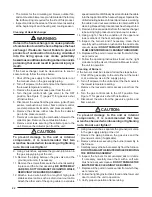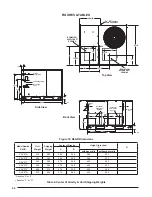
9
WARNING:
CARBON MONOXIDE POISONING HAZARD
Failure to follow the steps outlined below
for each appliance connected to the venting
system being placed into operation could result
in carbon monoxide poisoning or death. The
following steps shall be followed with each
individual appliance connected to the venting
system being placed in operation, while all
other appliances connected to the venting
system are not in operation:
1. Seal any unused openings in the venting
system.
2. Inspect the venting system for proper size and
horizontal pitch, as required in the National Fuel
Gas Code, ANSI Z223.1/NFPA 54 or the CSA
B149.1, Natural Gas and Propane Installation
Codes and these instructions. Determine that
there is no blockage or restriction, leakage,
corrosion and other defi ciencies which could
cause an unsafe condition.
3. As far as practical, close all building doors
and windows and all doors between the space
in which the appliance(s) connected to the
venting system are located and other spaces
of the building.
4. Close fi replace dampers.
5. Turn on clothes dryers and any appliance not
connected to the venting system. Turn on
any exhaust fans, such as range hoods and
bathroom exhausts, so they are operating at
maximum speed. Do not operate a summer
exhaust fan.
6. Follow the lighting instructions. Place the
appliance being inspected into operation.
Adjust the thermostat so appliance is operating
continuously.
7. Test for spillage from draft hood equipped
appliances at the draft hood relief opening
after 5 minutes of main burner operation. Use
the fl ame of a match or candle.
8. If improper venting is observed during any of
the above tests, the venting system must be
corrected in accordance with the National Fuel
Gas Code, ANSI Z223.1/NFPA 54 and/or CSA
B149.1, Natural Gas and Propane Installation
Codes.
9. After it has been determined that each appliance
connected to the venting system properly vents
when tested as outlined above, return doors,
windows, exhaust fans, fi replace dampers and
any other gas-fi red burning appliance to their
previous conditions of use.
AVERTISSEMENT:
RISQUE D’EMPOISONNEMENT AU
MONOXYDE DE CARBONED
Le non-respect des consignes suivantes portant
sur chacun des appareils raccordés au système
d’évacuation mis en service pourrait entraîner
l’empoisennement au monoxyde de carbone ou
la mort. Les consignes suivantes doivent être
observées pour chaque appareil raccordé au
système d’évacuation mis en service si les autres
appareils raccordés au système ne sont pas en
service:
1. Sceller toute ouverture non utilisée de la systéme
d’évacuation;
2. S’assurer que la systéme d’évacuation présente
des dimensions et une pente horizontale
conformes à la norme ANSI Z223.1/NFPA
54, intitulée National Fuel Gas Code ou aux
codes d’installation CSA-B149.1, ainsi qu’aux
présentes instructions. S’assurer que la systéme
d’évacuation n’est pas bloquée, restreinte,
corrodée, qu’elle ne fuit pas et qu’elle ne présente
aucun autre défaut potentiellement dangereux;
3. Dans la mesure du possible, fermer toutes les
portes et fenêtres du bâtiment, et toutes les
portes entre la pièce où se trouve l’appareil
raccordé à la systéme d’évacuation et les autres
pièces du bâtiment.
4. Fermer les registres des foyers;
5. Mettre en service les sécheuses et tout autre
appareil qui n’est pas raccordé à la systéme
d’évacuation. Faire fonctionner à régime
maximal tout ventilateur d’évacuation, tel que
les hottes de cuisinière et les ventilateurs de
salles de bains. Ne pas mettre en service les
ventilateurs d’été.
6. Respecter les instructions d’allumage. Mettre en
service l’appareil à l’essai. Régler le thermostat
de manière à ce que l’appareil fonctionne sans
interruption;
7. Vérifier s’il y a débordement à l’orifice
d’évacuation du coupe tirage des appareils dotés
d’un coupe tirage 5 minutes après l’allumage
du brûleur principal. Utiliser la fl amme d’une
allumette ou d’une chandelle.
8. Si l’on constate, au cours de l’un des essais
qui précèdent, que l’évacuation est défi ciente,
corriger le système d’évacuation conformément
à la norm ANSI Z223.1/NFPA 54, National Fuel
Gas Code, et (ou) aux codes d’installation CSA
B149.1.
9. Après avoir déterminé que tous les appareils
raccordés à la systéme d’évacuation évacuent
correctement tel que prescrit ci-dessus,
rouvrir les portes et les fenêtres et remettre les
ventilateurs d’évacuation, les registres de foyers
et tout autre appareil fonctionnant au gaz à leur
état de fonctionnement initial.









































